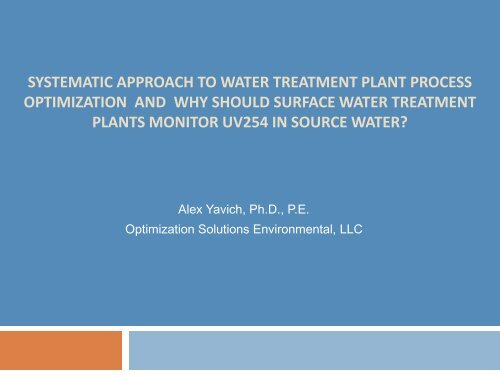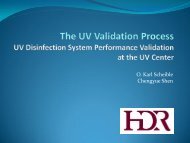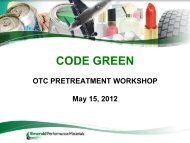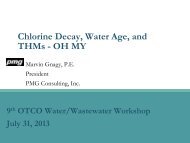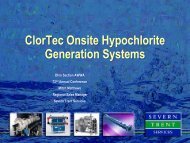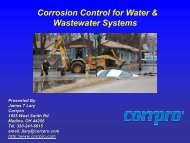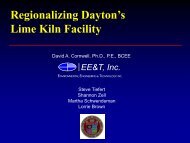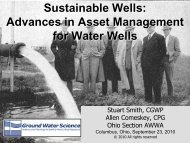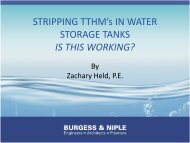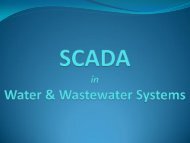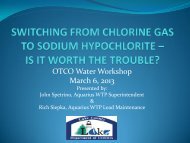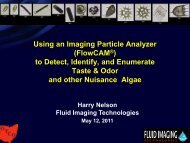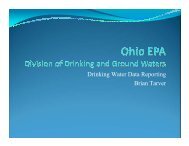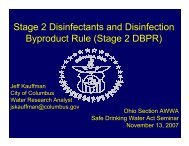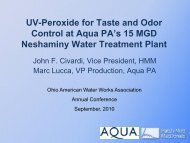Systematic Approach to Water Treatment Plant ... - Ohiowater.org
Systematic Approach to Water Treatment Plant ... - Ohiowater.org
Systematic Approach to Water Treatment Plant ... - Ohiowater.org
You also want an ePaper? Increase the reach of your titles
YUMPU automatically turns print PDFs into web optimized ePapers that Google loves.
SYSTEMATIC APPROACH TO WATER TREATMENT PLANT PROCESS<br />
OPTIMIZATION AND WHY SHOULD SURFACE WATER TREATMENT<br />
PLANTS MONITOR UV254 IN SOURCE WATER<br />
Alex Yavich, Ph.D., P.E.<br />
Optimization Solutions Environmental, LLC
What Will Be Discussed<br />
‣ Chemical feed rate optimization<br />
‣ Coagulant choice<br />
‣ Rapid and flocculation mixing<br />
‣ UV254 moni<strong>to</strong>ring
Chemical Feed Rate Optimization<br />
‣ Ensuring adequate chemical feed rates under all plant<br />
conditions is the first step in water plant process optimization<br />
‣ Optimization of chemical feed rates not only improves<br />
effluent quality and reduce chemical usage, but also helps<br />
identify other potential areas for improvement
Coagulation Feed Optimization<br />
Optimization<br />
goal<br />
Computer models can be developed <strong>to</strong> provide real time advisement <strong>to</strong> the<br />
opera<strong>to</strong>rs of the optimal chemical feed rates under various plant conditions
Case 1<br />
Three Rivers Filtration <strong>Plant</strong>, Fort Wayne, IN<br />
• Total capacity: 72 MGD<br />
• Source water: St. Joseph River
Case 1: Raw <strong>Water</strong> Quality
Case 1: <strong>Treatment</strong> train<br />
Fe 2 (SO 4 ) 3<br />
Lime<br />
PAC<br />
Fe 2 (SO 4 ) 3<br />
CO 2<br />
Influent<br />
Primary Coagulation /<br />
Lime Softening Stage<br />
Second Coagulation<br />
Stage<br />
Filtration<br />
Effluent
Chemical Feed Control at Fort Wayne <strong>Plant</strong>
Case 1: Chemical feed optimization<br />
1<br />
All costs in 2011 chemical prices
Optimal Coagulant<br />
‣ Optimal coagulant is the coagulant that best meets<br />
plant’s operational goals<br />
‣ By choosing the right coagulant, a water treatment<br />
plant can significantly improve its process<br />
performance and the quality of finished water
What are the Choices<br />
‣ Metal salts<br />
Turbidity removal through charge neutralization and sweep coagulation<br />
of colloidal particles<br />
Commonly used coagulants: alum, ferric sulfate, ferric chloride,<br />
polyaluminum chloride<br />
‣ Cationic polymers<br />
Charge neutralization is major coagulation mechanism<br />
Wide range of products available
Optimal Coagulant: Major Considerations<br />
‣ Raw water quality: turbidity, pH, alkalinity, NOM etc.<br />
‣ Operational objectives: effluent quality, chemical cost,<br />
sludge production, filter run etc.<br />
‣ <strong>Plant</strong> size<br />
‣ <strong>Treatment</strong> train: lime softening, UV disinfection etc.<br />
‣ Hardware: floccula<strong>to</strong>rs (variable/constant speed), clarifiers<br />
(conventional basins, upflow clarifiers, plate settlers etc.), filter<br />
configuration (media type, size, support etc.)
Case 2<br />
Holland <strong>Water</strong> <strong>Treatment</strong> <strong>Plant</strong><br />
Holland, MI<br />
Capacity:<br />
Source water:<br />
38.5 MGD<br />
Lake Michigan
Case 2: Raw <strong>Water</strong> Quality<br />
Raw <strong>Water</strong> Parameters<br />
Typical Range<br />
Temperature, o F<br />
32 – 77<br />
Alkalinity, mg/L as CaCO 3<br />
100 – 145<br />
Turbidity, NTU<br />
0.3 – 40<br />
Total <strong>org</strong>anic carbon, mg/L<br />
1.6 – 2.5<br />
UV254, cm -1 0.01 – 0.2
Case 2: Holland WTP Schematic<br />
Cl<br />
Coagulant<br />
Raw<br />
water<br />
Low lift pump<br />
MIxing<br />
Chamber<br />
Flocculation<br />
Basins<br />
Settling basins<br />
Filters<br />
Cl<br />
Treated<br />
water<br />
Clearwell<br />
High lift<br />
pumps
Operational Goal<br />
• Alum was his<strong>to</strong>rically employed for coagulation<br />
• Sludge production was problematic<br />
• Goal – reduce sludge production
Alternative Coagulants Tested<br />
• PACl<br />
• Alumer (a premanufactured blend of alum and cationic<br />
polymer)<br />
• “Seasonal” coagulation practice<br />
– Alum: December thru April<br />
– Alumer: May thru November
Coagulation Computer Models at HWTP
Results of Full-Scale Testing and<br />
Computer Simulation Analysis<br />
• PACl<br />
– Sludge could be reduced by up <strong>to</strong> 45 percent<br />
– Cost would increase by appr. 20%<br />
– Potential turbidity problems on four Integral Media Support (IMS)<br />
cap filters<br />
• Alumer<br />
– Sludge could be reduced by up <strong>to</strong> 35 percent<br />
– Cost would increase by 5-15%<br />
– Not cost effective at increased UV254<br />
• “Seasonal” coagulation practice<br />
– Sludge could be reduced by up <strong>to</strong> 25 percent<br />
– No cost increase (compared <strong>to</strong> alum)<br />
– More complex operation
<strong>Plant</strong>’s Best Choice (current practice)<br />
Alum and Cationic Polymer (fed separately)<br />
• Sludge reduced by up <strong>to</strong> 35 percent<br />
• Expected cost reduction by 25 - 30 percent (compared <strong>to</strong> alumer)<br />
• Consistent filtered turbidity<br />
• Improved operational control<br />
• Can be optimized <strong>to</strong> meet plant’s future goals
What Affected the Choice of Coagulant at HWTP<br />
• Raw water quality: turbidity and NOM<br />
• Operational goals: sludge production, effluent quality, chemical costs<br />
• <strong>Treatment</strong> train: sedimentation basins, filter configuration, feeding<br />
equipment
Rapid and Flocculation Mixing<br />
Raw<br />
water<br />
Low lift<br />
pump<br />
Coagulant<br />
Mixing<br />
Chamber<br />
Flocculation<br />
Basin<br />
Settling basin<br />
Mixing Intensity (G-value)<br />
G = (P/μV) 1/2<br />
G – velocity gradient, s -1<br />
P – power input, ft·lb/s<br />
µ – dynamic viscosity, ft·s/ft 2<br />
V – volume, ft 3
Rapid and Flocculation Mixing<br />
Raw<br />
water<br />
Low lift<br />
pump<br />
Coagulant<br />
Mixing<br />
Chamber<br />
Flocculation<br />
Basin<br />
Settling basin<br />
Operation Mixing Time G value, s -1<br />
Rapid mixing 1 – 60 sec 600 - 1500<br />
Flocculation 20 – 30 min 40 - 70
Case 3<br />
St. Joseph <strong>Water</strong> Filtration <strong>Plant</strong><br />
St. Joseph, MI<br />
Capacity:<br />
Source water:<br />
Raw turbidity:<br />
<strong>Treatment</strong>:<br />
12 MGD<br />
Lake Michigan<br />
1 – 60 NTU<br />
Alum coagulation<br />
No rapid mixer
Case 3: <strong>Plant</strong> Schematic<br />
Cl<br />
NaOH<br />
Alum<br />
Raw<br />
water<br />
Low lift pump<br />
Sludge<br />
Drain<br />
Accela<strong>to</strong>r Clarifiers (3)<br />
Filters<br />
Cl<br />
Treated<br />
water<br />
Clearwell<br />
High lift<br />
pumps
Case 3: Rapid Mixing Analysis<br />
Type MIxing time, s G value, s -1<br />
St. Joseph plant<br />
(hydraulic mixing in the pipe)<br />
10 - 60 100 - 400<br />
Mechanical mixers<br />
(for comparison) 10 - 60 600 - 1000<br />
In-line blenders<br />
(for comparison) 0.5 - 1 1000 - 1500
Case 3: Computer simulation analysis
Case 3: Effect of coagulant mixing
Case 4<br />
Holland <strong>Water</strong> <strong>Treatment</strong> <strong>Plant</strong><br />
Holland, MI<br />
Capacity:<br />
Source water:<br />
38.5 MGD<br />
Lake Michigan
Case 4: Effect of Flocculation Mixing on Filtered<br />
Turbidity
<strong>Water</strong> Quality Moni<strong>to</strong>ring: UV254<br />
‣ UV254 is a measure of ultraviolet absorption at a wavelength<br />
of 254 nm<br />
‣ UV254 is a surrogate measure of natural <strong>org</strong>anic matter<br />
(NOM) in water
Why Should Surface <strong>Water</strong> <strong>Treatment</strong> <strong>Plant</strong>s<br />
Moni<strong>to</strong>r UV254 in Raw <strong>Water</strong><br />
Coagulation<br />
Filtration<br />
Clarification<br />
UV254<br />
DBP control<br />
Taste and Odor<br />
Control<br />
Disinfection
Case 5: Effect of UV254 on coagulant demand<br />
Lake Michigan Filtration <strong>Plant</strong>, Grand Rapids, MI<br />
Capacity – 130 MGD<br />
Source – Lake Michigan
Case 6: Effect of UV254 on effluent turbidity<br />
South Haven <strong>Water</strong> <strong>Treatment</strong> <strong>Plant</strong>, South Haven, MI<br />
Capacity – 4 MGD<br />
Source – Lake Michigan
UV254 Analysis is Fast and Simple
Benefits of UV254 Moni<strong>to</strong>ring<br />
‣ Improved chemical feed control<br />
‣ Consistent effluent turbidity<br />
‣ Reduced chemical costs<br />
‣ Important fac<strong>to</strong>r in identifying the “optimal”<br />
coagulant<br />
‣ Improved DBP control<br />
‣ Helps optimize UV disinfection
Summary<br />
Ensure that chemical feed rates are satisfac<strong>to</strong>ry under all<br />
plant conditions<br />
Does the plant use the right coagulant<br />
Verify that rapid mixing operation is adequate<br />
Adjust, if possible, flocculation speed at least seasonally<br />
Implement raw water UV254 moni<strong>to</strong>ring (surface WTPs)
Q&A<br />
Alex Yavich<br />
Ph. (616) 975-0847<br />
E-mail: yavichal@osenv.com<br />
Web: www.osenv.com


